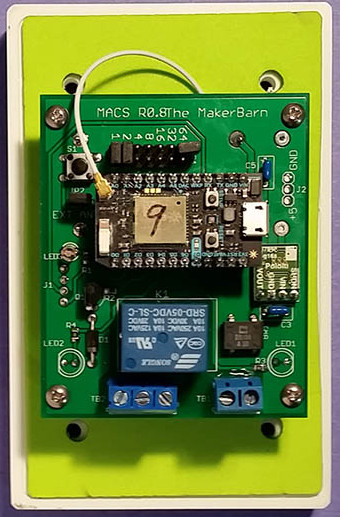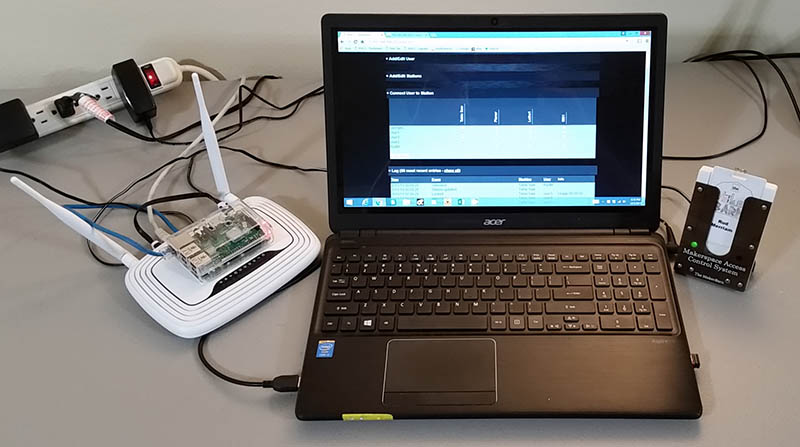The MakerBarn is a new makerspace between The Woodlands and Tomball, TX (north of Houston). [George Carlson], one of the founders and a retired design engineer, wanted to make sure only members certified on a machine could use it. He worked with [Kolja Windeler] to create the MACS or Makerspace Access Control System. He has one video explaining MACS and, after the break, another explaining the browser based user interface for the system.
 A control box, [George] calls them stations, controls the power to a machine. Member badges have an RFID tag that is read when inserted into the station’s reader. If the member is authorized to use the machine, the power is enabled. For safety, the member’s badge must remain in the reader to maintain power. The reader uses a Photon board from Particle with a WiFi link to a Raspberry Pi server.
A control box, [George] calls them stations, controls the power to a machine. Member badges have an RFID tag that is read when inserted into the station’s reader. If the member is authorized to use the machine, the power is enabled. For safety, the member’s badge must remain in the reader to maintain power. The reader uses a Photon board from Particle with a WiFi link to a Raspberry Pi server.
[Kolja] developed a Pi system to maintain a database of member numbers and the machines they can use. The list is sent to the stations periodically or when updates occur. The user interface is browser based on the MakerBarn’s LAN so it can be maintained by a computer or smartphone in the space. Presently 21 MACS modules have been built with some going to Hanover University in Germany for their auto hobby shop.
Not only did [George] lead the effort on creating MACS but has been key to getting the construction done inside a pole barn to make the MakerBarn a reality.
















What a great solution, hopefully this will eventually be open sourced as I would like to build a dozen of these :-)
I had a similar idea once, but I was just going to use it to keep track of who used a machine last, so there would be no finger-pointing when the machine ends up damaged from misuse. By adding the authorization system, this incarnation helps prevent the misuse from occurring in the first place.
This looks very similar to the ACnode system developed by the London Hackspace :)
I have not seen that system before. Are there any photos of the completed system? I like their idea of the machine out of service mode.
I visited their space last year and saw it in operation. unfortunately it is not well implemented and documented. The github documentation is inaccurate as they have changed their firmware/hardware without documenting it.
I’d also like to see this opened sourced. I took a quick look at the ACnode from the London Hackspace (https://hackspace.org.uk/view/Project:Tool_Access_Control/Solexious_Proposal), I wonder if they ever got it going. Their github repo (https://github.com/solexious/ACNode) hasn’t had any activity for a couple years.
Put me down for thirding the motion. Tx/Rx in central Houston has been talking about doing something like this for at least two or three years. Having a codebase and recommended hardware to work from would probably allow them to get the project (further) off the ground.
Fourthed?
This is nifty – I like the “card has to stay in place” solution, as we were trying to figure out how to do it safely with timers.
We’re looking to build a similar system that ties into our membership database on an external service. That way we’ll have updated data when we run training classes (from the class registry) as well as automatically integrating the access control system with our payment processor. Another integration we’re working towards is showing a public calendar on the site to indicate that the machine is in use. This type of system also enables per-hour machine rates easily enough.
There’s a lot of benefits here.
It’s actually in full time use!
A more recently updated wiki page: https://wiki.london.hackspace.org.uk/view/Project:Tool_Access_Control
Do any of these systems use something better than unencrypted card IDs? These are trivial to clone.
I’ve searched for more than a year and been unable
You are correct. For a few dollars you can purchase a devices that is capable of coping the cards. So I certainly would not use standard EM4100 type RFID cards for building access. In the shop they work fine, the MACS log would quickly show duplicate badge usage.
The code has been provided on GitHub, another pull request is pending for some updates. https://github.com/KoljaWindeler/macs
Has anyone synced this with WordPress or another CRM to share a database with those looking to make online reservations to equipment that would see equipment in use?
Hi Clint, I am looking for this as well. We got makerspace members with Woocommerce subscriptions, and would like to Sync it with the access system. Anyone know how to expand this?